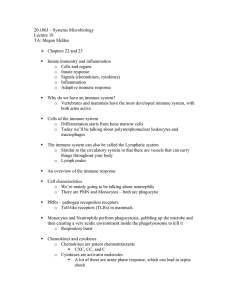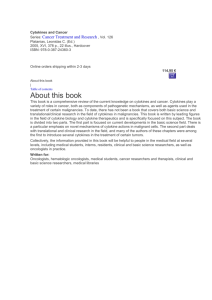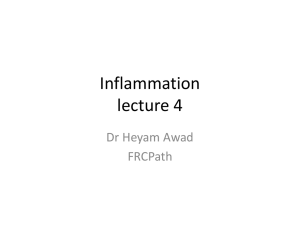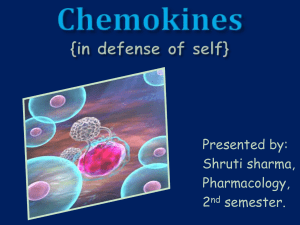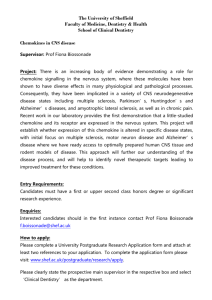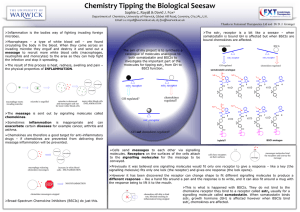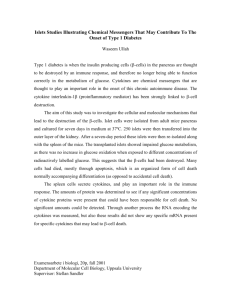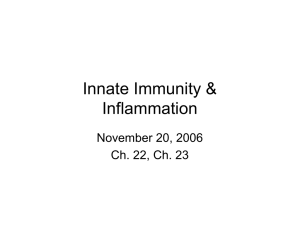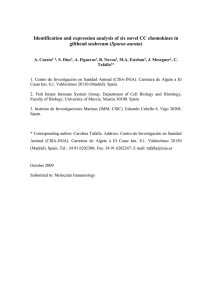Chapter 15 QUESTIONS 1. What is a cytokine?
advertisement
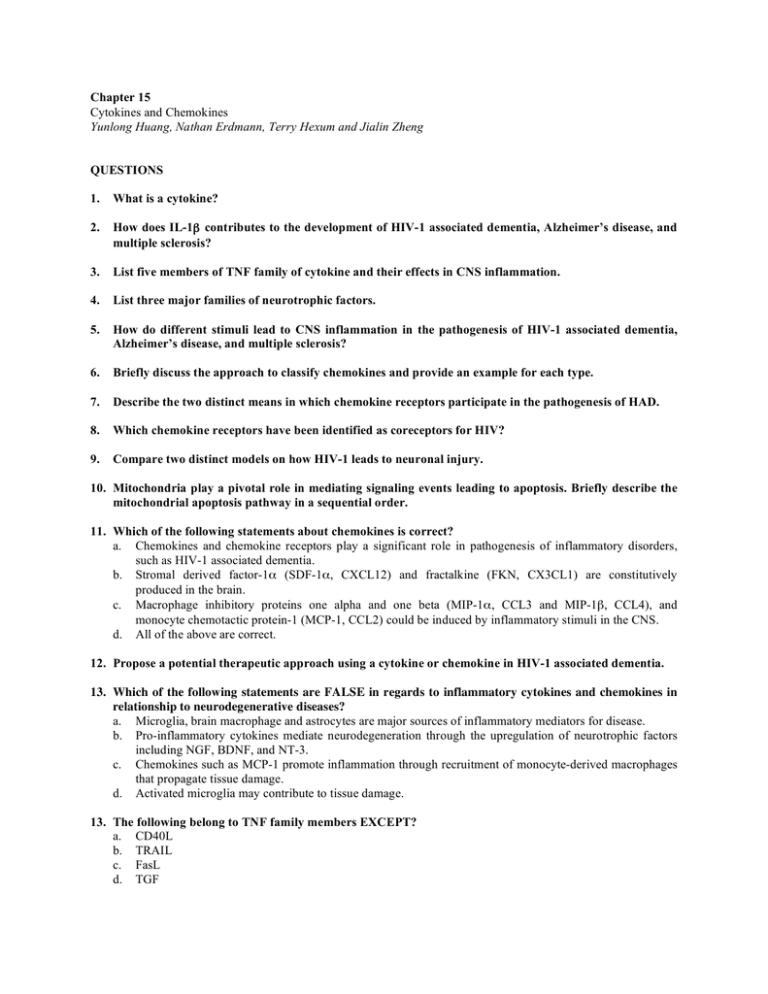
Chapter 15 Cytokines and Chemokines Yunlong Huang, Nathan Erdmann, Terry Hexum and Jialin Zheng QUESTIONS 1. What is a cytokine? 2. How does IL-1β contributes to the development of HIV-1 associated dementia, Alzheimer’s disease, and multiple sclerosis? 3. List five members of TNF family of cytokine and their effects in CNS inflammation. 4. List three major families of neurotrophic factors. 5. How do different stimuli lead to CNS inflammation in the pathogenesis of HIV-1 associated dementia, Alzheimer’s disease, and multiple sclerosis? 6. Briefly discuss the approach to classify chemokines and provide an example for each type. 7. Describe the two distinct means in which chemokine receptors participate in the pathogenesis of HAD. 8. Which chemokine receptors have been identified as coreceptors for HIV? 9. Compare two distinct models on how HIV-1 leads to neuronal injury. 10. Mitochondria play a pivotal role in mediating signaling events leading to apoptosis. Briefly describe the mitochondrial apoptosis pathway in a sequential order. 11. Which of the following statements about chemokines is correct? a. Chemokines and chemokine receptors play a significant role in pathogenesis of inflammatory disorders, such as HIV-1 associated dementia. b. Stromal derived factor-1α (SDF-1α, CXCL12) and fractalkine (FKN, CX3CL1) are constitutively produced in the brain. c. Macrophage inhibitory proteins one alpha and one beta (MIP-1α, CCL3 and MIP-1β, CCL4), and monocyte chemotactic protein-1 (MCP-1, CCL2) could be induced by inflammatory stimuli in the CNS. d. All of the above are correct. 12. Propose a potential therapeutic approach using a cytokine or chemokine in HIV-1 associated dementia. 13. Which of the following statements are FALSE in regards to inflammatory cytokines and chemokines in relationship to neurodegenerative diseases? a. Microglia, brain macrophage and astrocytes are major sources of inflammatory mediators for disease. b. Pro-inflammatory cytokines mediate neurodegeneration through the upregulation of neurotrophic factors including NGF, BDNF, and NT-3. c. Chemokines such as MCP-1 promote inflammation through recruitment of monocyte-derived macrophages that propagate tissue damage. d. Activated microglia may contribute to tissue damage. 13. The following belong to TNF family members EXCEPT? a. CD40L b. TRAIL c. FasL d. TGF 15. Cytokines and Chemokines Yunlong Huang, Nathan Erdmann, Terry Hexum and Jialin Zheng 2 14. The following cytokines serve as pro-inflammatory factors EXCEPT? a. IL-10 b. IL-1 c. IFNd. IL-6 16. Which of the following statements about type I and type II cytokines are incorrect? a. Type I and type II cytokine families are classified based upon the structural homology of their receptors. b. Type I and type II cytokine families are comprised of both Th1 and Th2 cytokines. c. Interferons are type II cytokines that promote viral growth while serving as anti-inflammatory and immunomodulatory factors. d. Members of the type I cytokine family share a characteristic motif consisting of an extracellular region containing four helices. 17. Which anti-HIV therapeutics specifically target the infecting agent? a. Co-receptors: CCR5 and CXCR4 b. Viral receptor: CD4 c. Viral enzymes required for replication d. Adenylate cyclase 18. The chemokine co-receptors for HIV-infection infection are? a. CXCR7 and CCR1 b. CCR1 and CCR5 c. CXCR4 and CCR1 d. CXCR4 and CCR5 19. ELR+ chemokines target which cell type? a. Monocytes and lymphocytes b. Neutrophils c. Progenitor cells d. Monocytes 20. Chemokines are defined by the organization of their N-terminal cysteine residues. Which of the following is not representative of a chemokine classification? a. CC b. CXC c. CXXC d. C 21. Which of the following is the most potent chemoattractant for monocytes and macrophages? a.CXCL12 b. CXXXCL3 c. CCL2 d. CXCL8 15. Cytokines and Chemokines Yunlong Huang, Nathan Erdmann, Terry Hexum and Jialin Zheng 3 ANSWERS 1. What is a cytokine? A cytokine is a small protein that is released from various cell types, targets a specific receptor and initiates a signaling cascade that then produces some function. 2. How does IL-1β contributes to the development of HIV-1 associated dementia, Alzheimer’s disease, and multiple sclerosis? IL-1β is a potent proinflammatory cytokine. HIV-1 infection, Aβ deposition, and the infiltration of activated T cell into the CNS will lead to IL-1β production in microglia and macrophage. IL-1β induces genes associated with inflammation and amplifies inflammation in the CNS particularly in the chronic state. 3. List five members of TNF family of cytokine and their effects in CNS inflammation. TNF-α, TNF-β, Fas ligand (FasL), CD40 ligand (CD40L), and TNF-related apoptosis-inducing ligand (TRAIL). Members of the TNF family are known for their apoptosis-inducing ability, though they have additional biological effects. TNF-α is an inflammatory Th1 cytokine released during infection; CD40L is a strong activator of macrophage; FasL and TRAIL modulate immune responses through the induction of apoptosis but also have been suggested to be involved in destructive effects toward tissue in CNS inflammation. 4. List three major families of neurotrophic factors. Neurotrophin family, ciliary neurotrophic factor (CNTF) family, and GDNF (glial cell line-derived neurotrophic factor) family. 5. How do different stimuli lead to CNS inflammation in the pathogenesis of HIV-1 associated dementia, Alzheimer’s disease, and multiple sclerosis? In HAD, HIV-1 infection of macrophage in the CNS leads to the activation of macrophage and microglia. Activated macrophage and microglia release cytokines, and chemokines that can be detrimental to neurons. Neuronal injury recruits additional macrophages. This process of injury, recruitment, and activation forms a positive feedback loop and advancing the disease state. In AD and MS, either Aβ priming or T cell-mediated of macrophage/microglia activation may utilize similar inflammatory cytokines and chemokines to cause the pathogenic effects on the CNS. 6. Briefly discuss the approach to classify chemokines and provide an example for each type. Chemokines are classified based upon the arrangement of two N-terminal cysteine pairs. Chemokines with two cysteines separated by one amino acid are called CXC or α with examples being SDF-1 (CXCL4) and IL-8 (CXCL8). Chemokines with two cysteines immediately next to each other are called CC or β chemokines, with examples including MCP-1 (CCL2), MIP-1α/β(CCL3,4), and RANTES (CCL5). The two remaining groups are called C or δ chemokines and CX3C or γ chemokines and are represented by Lymphotactin (XCL1) and Fractalkine (CX3CL1). 7. Describe the two distinct means in which chemokine receptors participate in the pathogenesis of HAD. Chemokines are critical to HAD pathogenesis in that they provide the essential co-receptors for the entry of virus into target cells as well as actively participating in the recruitment of effector cells to sites of inflammation. This recruitment allows peripheral immune cells to enter the brain, and also allows the dissemination of virus to invading immune cells facilitating CNS inflammation. 8. Which chemokine receptors have been identified as coreceptors for HIV? CCR5, CXCR4, and CX3CR1. 9. Compare two distinct models on how HIV-1 leads to neuronal injury. Two distinct models have been proposed as mechanisms in HAD pathogenesis. The first is the direct neuronal injury model, where viral proteins (gp120, tat and Vpr) directly interact with neurons causing neuronal injury through various mechanisms. The second model, referred to as the indirect neuronal injury model, proposes that neurons die as bystanders when excessive local concentrations of soluble pro-inflammatory and neurotoxic factors are released by infected MP and astrocytes. 15. Cytokines and Chemokines Yunlong Huang, Nathan Erdmann, Terry Hexum and Jialin Zheng 4 10. Mitochondria play a pivotal role in mediating signaling events leading to apoptosis. Briefly describe the mitochondrial apoptosis pathway in a sequential order. The mitochondrial pathway is initiated through various stress signals that impair the mitochondrial membrane integrity. The BH3–only BCL-2 family proteins, such as Bid, Bad, Bim, and PUMA, serve as sentinels to these stress signals. Once activated, BH3-only proteins translocate to the outer membrane of mitochondria, where they trigger the oligomerization and activation of both Bax and Bak. In turn, Bax and Bak cause the release of cytochrome c (cyto c) and other apoptogenic factors, including second mitochondrial-derived activator of caspase (SMAC), Htr2, apoptosis inducing factor (AIF), and endonuclease G (EndoG). Cyto c then binds the cytosolic adaptor protein, Apaf-1, mediating the formation of the apoptosis complex “apoptosome”. Such complexes lead to the activation of caspase-9, which further processes and activates the effector caspases, procaspase-3, 6, or 7. Effector caspases then cleave death substrates and complete apoptosis. 11. Which of the following statements about chemokines is correct? a. Chemokines and chemokine receptors play a significant role in pathogenesis of inflammatory disorders, such as HIV-1 associated dementia. b. Stromal derived factor-1α (SDF-1α, CXCL12) and fractalkine (FKN, CX3CL1) are constitutively produced in the brain. c. Macrophage inhibitory proteins one alpha and one beta (MIP-1α, CCL3 and MIP-1β, CCL4), and monocyte chemotactic protein-1 (MCP-1, CCL2) could be induced by inflammatory stimuli in the CNS. d. All of the above are correct. 12. Propose a potential therapeutic approach using a cytokine or chemokine in HIV-1 associated dementia. Because of the great diversity among cytokines, there are nearly limitless potential therapeutic avenues through their manipulation. The use of anti-inflammatory cytokines such as TGF-β and IL-10 may be useful for preventing or limiting excessive inflammation in some neurodegenerative disorders. On the other hand, inflammatory cytokines such as IFN-γ or TNF-α may potentially be used to enhance the immune response, perhaps facilitating the removal of immune insults such as HIV or Aβ protein aggregates. One final approach may be through the manipulation of survival pathways; for instance, pro-apoptotic factor TRAIL may have therapeutic uses for clearance of infected cells, whereas BDNF may be a useful agent to enhance neuron viability. It is important to keep in mind a major pitfall is the means of delivery for this type of treatment and ensuring the specificity of response to the area of insult. 13. b 14. d 15. a 16. c 17. c 18. d 19. b 20. c 21. c
